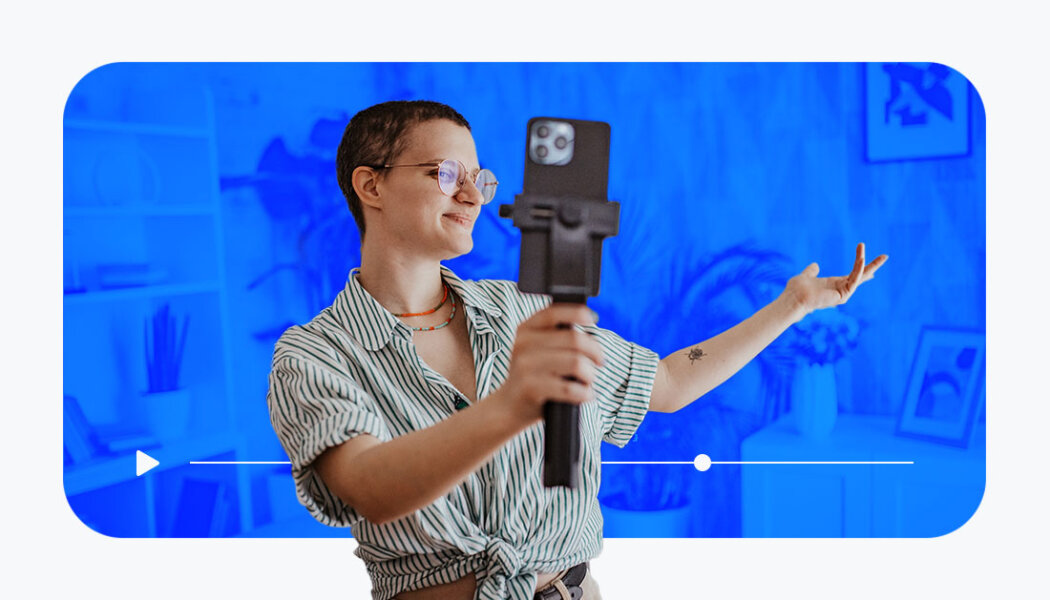Working in the creator economy is one of the most exciting and lucrative opportunities today. It’s constantly growing and evolving, which is why keeping up with creator economy trends for 2026 is key to staying ahead of the competition.
The results speak for themselves — the top 10% of creators earn an average of $48,500 per month. By implementing the right strategies and maintaining consistent effort, creators can achieve noticeable growth.
Whether you’re a new or established creator, there’s always room to grow. You can do this by updating your content to align with emerging video creator trends or by exploring new monetization opportunities, from digital and physical products to affiliate marketing and partnerships with brands through sponsorships and user-generated content (UGC) projects.
If you’re not sure where to start, we created this guide, highlighting the top creator economy trends to help you plan your next steps.
Creators are increasingly using community and membership features to deepen connections, deliver exclusive content, and keep audiences engaged, turning casual viewers into loyal, long-term supporters.
The state of the creator economy in 2025
It’s no secret that the creator economy is booming. But most people don’t know what’s driving this massive creator economy growth — or how newer platforms beyond YouTube, Facebook, Instagram, are opening amazing growth opportunities for ambitious creators.
So what standout numbers should an aspiring creator see as proof of how large the opportunity in the creator economy really is? This table gives a quick snapshot of key creator economy financial info, including global market size, growth rates, number of creators worldwide, and average income levels.
| Metric | 2024 | 2025 |
| Global market size | $205.25B | $252.33B |
| Compound annual growth rate (CAGR) | 23.3% | 23.3% |
| Number of creators worldwide | 200M+ | 207M+ |
| Average creator income (ad-based) | <$1,000/year for most | <$1,000/year for most |
Creators can accelerate their growth by targeting high-value niches, leveraging the best platform tools and features to engage their audiences, and using effective monetization strategies to thrive in this fast-growing market.
A closer look at creator economy trends
To keep pace with the rapid creator economy growth, it’s important to understand current trends among creators. From evolving viewer consumption habits to shifts in platform payouts, the rise of AI tools, and new monetization opportunities, growing creators have a lot to consider as they plan their strategies for 2026.
We’ll break down each of these trends so you can plan smarter, refine your content strategy, and position yourself for sustainable growth throughout 2026.
1. Long-form content is alive and well
Social media wants you to believe that short-form content is all that matters today, but long-form content is very much alive and experiencing what some might call a resurgence.
More creators are discovering that long-form content offers greater depth and attracts curious audiences eager to expand their knowledge and build expertise.
This trend is reflected in engagement on Uscreen, where audiences are spending significant time with content:
- Average session time: 18.5 minutes
- Average live stream watch time: 47 minutes
- Average video length: 27 minutes
I’m excited that longer-form content has become more popular again, with audiences keen to digest informative and high-value content from authority figures/brands. I think this is fantastic as it provides a really great opportunity for those of us in niche sectors to use our skills and experience to stand out with our content. Most importantly, we can do that without having to resort to short-form content aimed only at providing entertainment, which we may not be comfortable with, and may not fit with our brand image.
Takeaway: Leaning into long-form content is a way for your audience to gain deeper, more detailed knowledge or insights. Building a collection of long-form content will also position you as a thought leader and authority in your niche.
2. Platform payouts are (still) disappointing
Early versions of creator fund-based programs succeeded in pulling large crowds of creators from almost every niche to social platforms. But like most new ideas, these programs have evolved.
For example, TikTok and Facebook have made substantial changes to how much they pay creators, eventually arriving at amounts as low as 1-2 cents for 1,000 views.
Here’s a current look at how payouts compare across major platforms:
| Platform | Estimated payout per 1,000 views | Estimated earnings for 1M views | Notes |
| TikTok | $0.02—$0.05 | $20—$50 | Creator Fund and other monetization methods |
| $0.01—$0.05 | $10—$50 | Varies by program and engagement | |
| YouTube | $2—$12 per 1,000 views | $2,000—$12,000 | Varies by niche and audience engagement |
And creators aren’t ditching platforms in protest. For some, it’s a matter of ROI. Mr. Beast recently declined Elon Musk’s offer to post content on X, mentioning that his videos cost millions of dollars to make and that even with billions of views on X, he’d run at a loss due to the platform’s current revenue share split.

While these numbers may seem low, creators are finding success elsewhere by building owned audiences, offering subscriptions, and monetizing their expertise directly.
For example, Katja from Pilates & Yoga with Katja moved beyond unpredictable platform payouts by launching her own membership site, now earning over $8,000 per month in recurring revenue while maintaining full control over her content and community.
The dwindling of creator funds is a trend that I am not excited about. I’ve seen this as a trend on platforms like TikTok and Instagram. It takes a lot to create and post on platforms, and although creators should never only depend on this stream of income, it is sad that they make almost nothing trying to feed an algorithm.
Takeaway: Relying solely on views and ad-based revenue can be challenging, so focus on monetizing your content in other ways. Leverage affiliate marketing, create and sell merch and digital products, seek sponsorship deals, and more. Monetizing content in multiple ways can generate more income with fewer views.
3. Video content is evolving
While you can produce many forms of content, recent data points to live streaming and interactive content as high-performing for creators. At Uscreen, live streams average 179 views per session, with peaks of 20,502, highlighting the reach of live content.
There’s a lot of live streaming that is being leveraged by our creators, on their free platform, YouTube, and social, to drive new viewership to get discovered, but then also use those live streams as a way to promote their memberships, paid content, and paid products.
Carousel-style subscription content is also growing in popularity, as more audiences embrace apps and streaming services. Many creators are now using Netflix-style platforms to deliver content wherever their viewers are located, building loyal, paying communities.
I’m excited about the implementation of higher quality storytelling. It’s always been something close to my heart, but it seems that this year, creators are prioritizing it more than ever. In an age of overstimulation, individuals are seeking to establish authentic relationships. Stories, I believe, are the ideal medium for fostering these connections in a genuine and effective way.
For creators, the key to driving engagement and building loyal audiences is authenticity and quality. Whether through live streams or interactive experiences, compelling storytelling is what connects with audiences and keeps them coming back.
Takeaway: You can take advantage of the rapid growth of the OTT market by building your own live streaming and video-on-demand platforms with paid memberships. All-in-one video platforms like Uscreen make it simple to build and scale a lucrative creator business without coding skills or technical expertise.
With demand for quality content at an all-time high, now is the time to turn your stories into a sustainable source of income. Want to see how it’s done? Visit our customer stories to see how creators just like you have turned their ideas into real, thriving video businesses.
4. Owning your audience matters
COPY: moving to a platform like Uscreen is key.
If creating YouTube videos were a game, the constant algorithm changes and demonetization would feel a lot like playing on hard mode. For years, platforms have adjusted the way they reward content, shifting from prioritizing engagement to favoring watch time.
And while terms like engagement and watch time are common, there are less obvious factors that influence how platforms distribute content. These unseen levers determine what creators need to do to generate metrics that translate into reliable income.
Relying on the next algorithm shift on any given platform doesn’t have to define your livelihood. Instead, use YouTube as a marketing funnel for your membership platform.
With its broad reach, YouTube can attract new audiences and prepare them for your content, turning casual viewers into paying members. Learn more about this strategy in the video below.
That’s how you establish a real and sustainable business. When you own your communication channel, you’re no longer at the mercy of changing platform metrics or algorithms.
Instead, you can focus on your creative vision to produce high-quality content that serves your community and generates a more sustainable, long-term income.
For example, online entrepreneur and content creator Ali Abdaal understands the importance of turning platforms into pipelines that lead viewers to memberships. He uses a website to collect email addresses for his newsletter, which he uses to promote new courses and products.
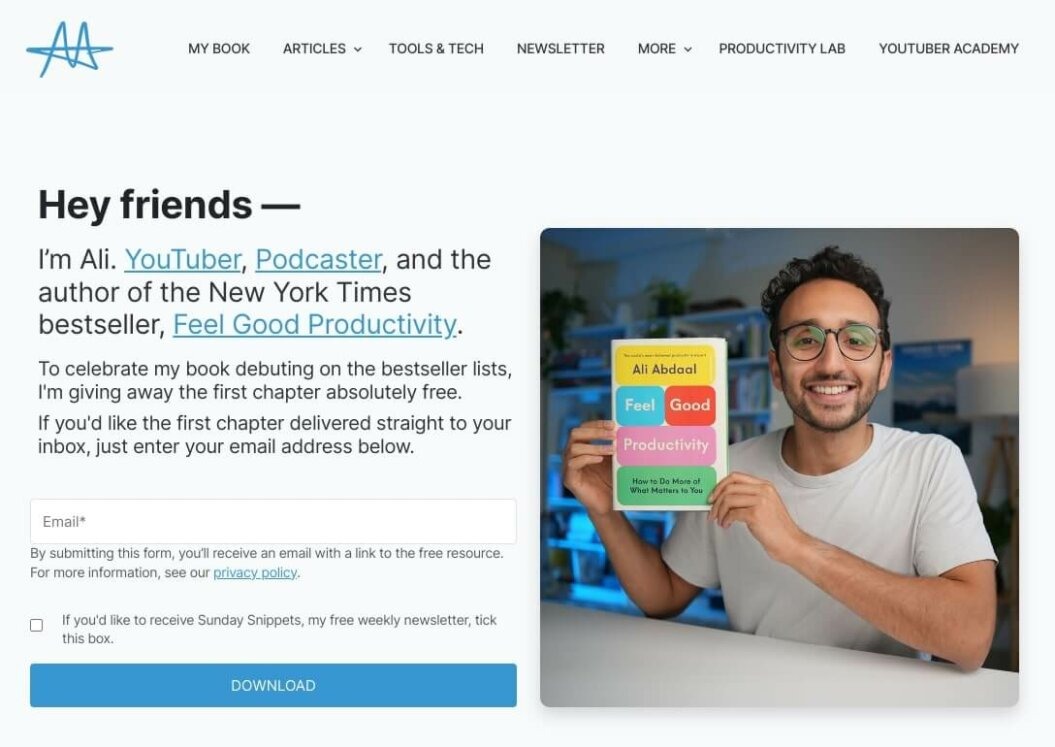
Other channels can still be used to reach new audiences, but when monetizing your content, relying on platforms you own helps you build a more sustainable income.
I’m excited to see more creators taking their control back. Instead of being algorithm-dependent, creators are monetizing through memberships and selling digital products like templates, eBooks, and courses directly to their fans in addition to brand deals and affiliate marketing. Multiple streams of income is the name of the game and those who embrace that will find success.
Takeaway: Explore monetization strategies that rely less on algorithms. For example, there are YouTube monetization alternatives to ad revenue through email lists, newsletters, or your own membership platform that establish direct contact with your audience.
5. AI tools can boost productivity
AI is changing the way creators work, from researching and producing content more efficiently to serving as a digital assistant for administrative tasks and community management. With 88% of marketers considering AI as essential for meeting modern audience expectations, understanding its role is key to staying competitive.
Creators usually use AI for content ideas, spotting what’s resonating in comments, writing scripts, and turning long-form video into short clips. We encourage them to also think of AI as an assistant, using it to bounce ideas, refine concepts, and help with email sequences and lead nurturing, while keeping the human touch in the copy.
Creators use AI to:
- Automate video captioning or transcription
- Summarize comments to identify trending topics
- Draft email sequences or social media posts for to edit and personalize later
- Schedule posts and track engagement
- Generate topic ideas
- Analyze performance insights
The benefits of AI’s speed and access to information are clear, which is why 76% of content creators use AI for basic content creation and generating copy. But relying on AI to produce all content can weaken your brand’s authenticity if you skip the human element.
Communities thrive when people know, like, and trust the ideas they encounter, and when these core pillars are weakened, audiences are less likely to return to content that feels inauthentic, impersonal, or automated.
Content creation is an art and it is much more compelling with our unique perspective. There seems to be a trend of “over-outsourcing” and relying too heavily on AI and automations. I’m all for leveraging tech to add more time back into your schedule but as content creators we really should temper that more. Content creation is an art and it is much more compelling with our unique perspective. We should be using AI as a production assistant, not a director.
Takeaway: AI can help you produce more content faster and make tasks like research and outlining easier, but its benefits don’t replace the value of human creativity. Use it as a supporting tool to identify ideas that you can refine with your own insight and personality.
6. Brands are collaborating more with creators
Many brands have small, agile marketing teams that struggle to keep up with fast-moving creator economy trends. Partnering with influencers allows them to expand their reach and leverage authentic voices to connect with highly targeted audiences.
As brands recognize the value of influencer collaboration, they now bring creators into campaigns earlier to shape strategy and messaging that better resonates with their audiences.
Brands will leverage creators earlier for consulting on the campaign. This year the number of brand collaborations with TikTok creators will increase, and the relationship between brands and all creators will continue to become less transactional, more collaborative, and brands will realize the value of bringing on creators into the process as early as possible. Brands will leverage creators earlier for consulting on the campaign, they will lead with curiosity and ask the creators more questions on how the brand should communicate with their audience instead of instructing, and brands will create deeper relationships with the creators that drive value.
You can attract these opportunities by defining your personal brand and consistently producing reliable, high-quality content that nurtures a loyal, engaged audience, making you a natural fit for authentic brand partnerships.
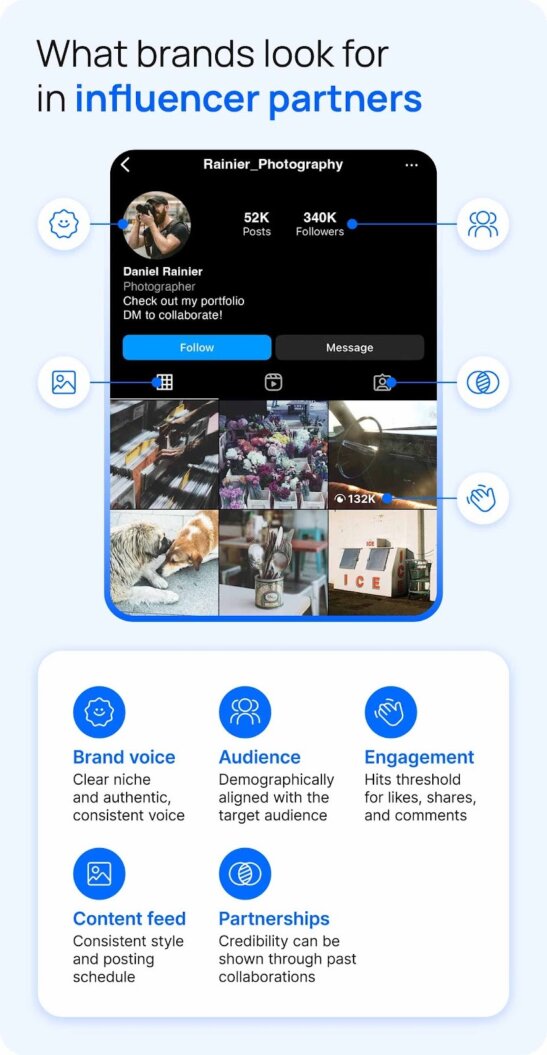
Takeaway: Brand partnerships and collaborations are becoming more authentic and mutually beneficial. The next time you land a brand deal, advocate for yourself to be involved early in the process to keep it aligned with your brand and deliver the best results.
7. Building a community drives stability
Creating a community is the strongest way to build a scalable creator business. Communities of individuals invested in learning and growing alongside like-minded peers are more likely to provide consistent support for your brand. In competitive markets, this loyalty reduces churn, increases lifetime value, and provides a buffer against volatility.
Creators can keep their communities engaged by regularly sharing content like live office hours, workshops, and behind-the-scenes insights. Interacting personally with members in comments helps make the community feel more intimate, and implementing their feedback keeps members invested.
The right community apps also make it easier to build, manage, and engage with members, fostering meaningful interactions and a thriving, active community.
One example of this is Justin Rhodes, who launched a paid membership platform with Uscreen for Abundance+, a homesteading content platform that teaches people how to grow their own food and live off the land back in 2021. In 2023, he crossed the $100K a month revenue mark through recurring membership revenue.

Or take Prodigies, a subscription music education platform founded by Rob Young. As a content creator, Rob wanted to find a smarter and more scalable way to share his passion for teaching, but small classroom settings proved limiting.
With Uscreen, Rob has scaled Prodigies to $40K+ a month and redefined success as a niche educator. He has several revenue streams, too. From selling big-ticket items to using shoppable videos to promote merchandise and digital products, he’s been able to scale his business and grow his income successfully.
A solid community is a lot like that one squad member who always has your back. Increasingly, creators are seeing the value of adding community to their social media presence and networks through platforms such as Discord and Guild. Not only does this help creators avoid daily battles with ever-changing social media platform algorithms to reach their audiences, community helps deepen relationships with fans and also gives them an opportunity to explore additional revenue streams with members. Creators are using monetization techniques such as tokenizing their communities, developing recurring revenue models through subscriber community spaces. Community doesn’t just happen.” It takes time and effort – something that creators innately understand, as many have built their personal brands from nothing.
Takeaway: A strong community is one of the most important drivers of long-term creator success and financial stability. Invest time into building, nurturing, and monetizing your online community — in that order.
8. Companion content elevates storytelling
Content doesn’t have to serve just one purpose. Savvy creators understand that staying top of mind with relevant messaging helps capture more attention, leads, and customers. Repurposing your creative work lets you maximize impact and make the most of every opportunity.
Repurposing content doesn’t have to be time intensive, especially for creators who focus on live-streamed content. For example, Uscreen creator Marnie Alton of M/BODY makes $40K a month by turning her live streams into video on demand (VOD).
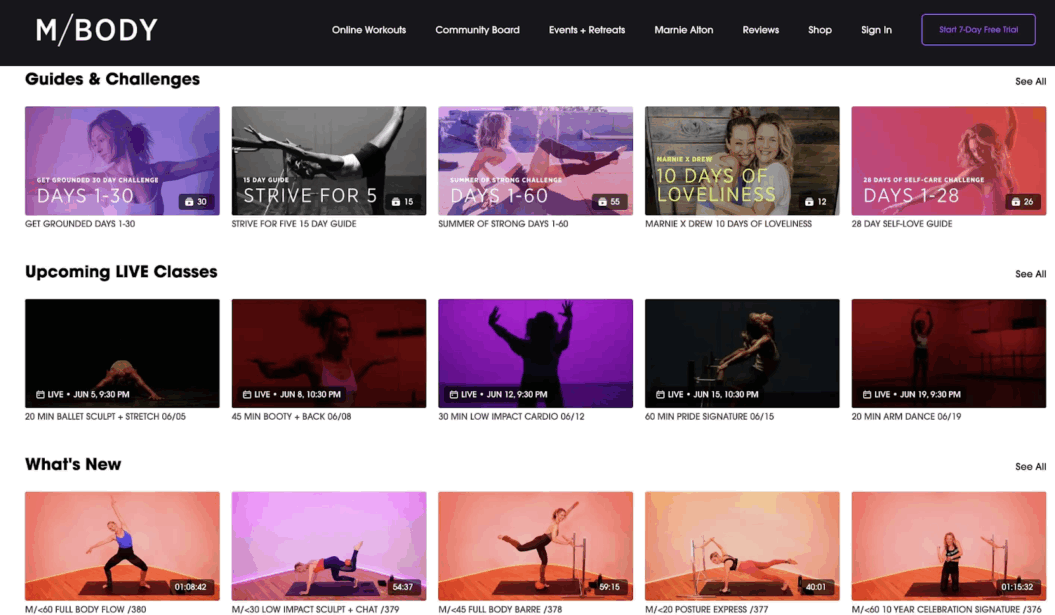
Instead of spending extra time creating new videos, her streams are automatically uploaded to her content library, allowing viewers to watch or rewatch at their convenience while she focuses on engaging her community and planning future content.
Creators are now extending the runway for a given story to include companion content. Consumers are ingesting content in more ways and on more platforms than ever. One trend that has emerged and will be a driver going forward is the extension or repurposing of original content across other forms of media. We will no longer see a single streaming TV series or documentary that is done in isolation as a stand-alone piece of content. Creators are now extending the runway for a given story to include companion content. The ability to move across content platforms has taught consumers to want more from their content and to want flexibility in accessing it. Podcasts, like other content, no longer live solely in the realm of Spotify or other audio-only apps. Creators must be savvy to understand that all stories are now told in many ways and content served up through streaming, OTT apps and video vehicles now has an audience waiting for it there. Platforms like Amazon and Roku are now building their own smart TVs, an indication that the technology has both shaped and now drives consumer demand for streaming and internet-based content.
Takeaway: Your audience wants more than just your main content — they value bonus material and behind-the-scenes access. Repurpose your content into other formats or create companion content. These additions often take less effort than the main video but can deliver a big return on engagement and impact.
9. Quality storytelling wins
Netflix revolutionized online streaming and introduced subscription video on demand (SVOD) setting the standard for authentic, high-quality streaming content. As more people embrace apps and streaming services on their favorite devices, SVOD options are growing.
With 65% of viewers streaming content on mobile and TV apps instead of browsers, it’s becoming more important to make sure your content is accessible wherever audiences might be.
SVOD’s growth is staggering, proving that creators, whether they have large or niche audiences, can get in on the action with captivating storytelling. Quality storytelling starts with understanding your audience’s pain points and delivering content that educates, entertains, or inspires action.
It means crafting clear narratives, building consistent themes across videos, and creating a cohesive experience that keeps viewers coming back. Authenticity, relatability, and attention to production value are key.
I’m excited about the implementation of higher quality storytelling It’s always been something close to my heart, but it seems that this year, creators are prioritizing it more than ever. In an age of overstimulation, individuals are seeking to establish authentic relationships. Stories, I believe, are the ideal medium for fostering these connections in a genuine and effective way.
One example is Find What Feels Good. By bringing her YouTube success to Uscreen, creator Adriene Mishler focused on creating high-quality, engaging content and storytelling for her community, while Uscreen managed the technical and operational workload.
Add image from this page:
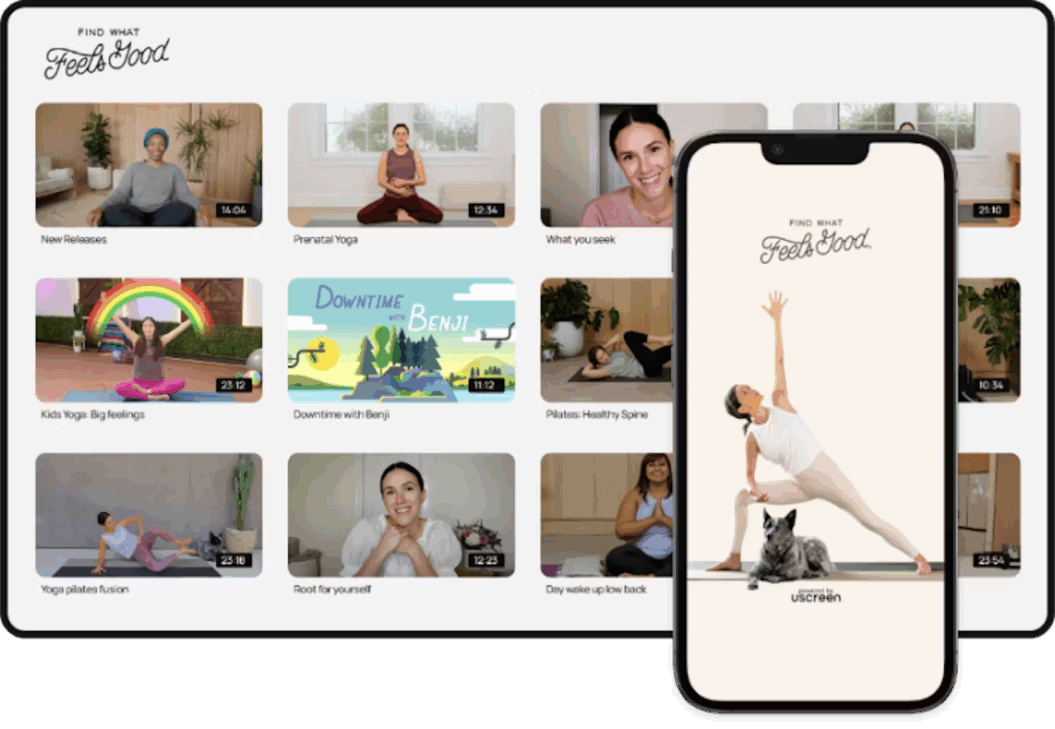
Takeaway: Demand for quality content is at an all-time high. You can carve out your own slice of the revenue pie by creating stories that resonate with a paying community. Want to see what that looks like? Visit our customer stories for a look at how creators turned their ideas into real, lucrative video businesses.
10. Diversified monetization is key
Owning your channel is the first step to protecting your revenue, but long-term success comes from diversifying how you earn it. Even with your own platform, relying on a single income source can leave you vulnerable to changing algorithms or audience behaviors.
Creators are finding success by combining memberships, digital products, and live streaming into one strategy. Memberships offer steady recurring income, while digital products like courses or eBooks turn expertise into scalable offers.
Live streaming adds a live, interactive component through paid events that directly connect you with your audience. With an all-in-one platform like Uscreen, it’s easy to manage it all without juggling different tools.
Takeaway: Diversifying your monetization not only protects your income but gives you room to grow. Multiple revenue streams mean you can focus on what matters most, creating high-quality content that connects with your audience. For a deeper dive on diversifying your income as a creator, check out this video by Jade Beason.
Start your creator journey with a membership site
By following these creator economy trends, you can stay current and grow your audience to maintain the momentum you’ve built. Understanding what works can help you turn your creativity into a sustainable and scalable business.
Platforms like Uscreen make it easy to take action. With video monetization tools, live streaming, and community engagement features, you can manage all aspects of your business in one membership website. This lets you focus on creating content and delivering a seamless experience for your audience.
Getting started doesn’t have to be complicated or expensive. Many beginner creators start on free platforms, build a community, and then transition to a membership site when ready. All you need is a little planning and your innate creative ability.
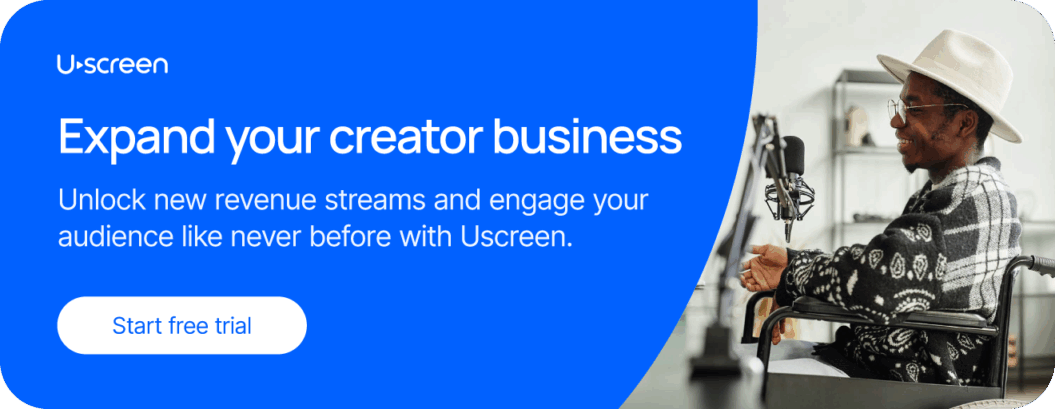
Creator Economy FAQs
The creator economy is expected to reach an estimated market size of about $250 billion in 2025.
The passion economy is made of people who run projects and build businesses around purpose-led movements. These can be specific lifestyles or ideologies that a group of people identify with or aspire to.
The creator economy consists of people who use their creative abilities to make an income. The passion economy includes creators who use their skills and talents to share their ideas, products, and services with the world.
The creator economy is driven by four factors, including:
Technology advancements: With technology evolving rapidly, the world is more connected than ever, and audiences are constantly seeking new content. Faster networks, better infrastructure, and widespread access have made it easier than ever for creators to reach viewers globally.
Platform options: A growing variety of platforms allows creators to connect with audiences in new ways, while evolving algorithms make it easier for new people to discover your content. These creator economy tools help creators build communities and expand reach efficiently.
Accessibility: Recording equipment is now affordable and easy to use, and a smartphone is often enough to get started. Editing software is free or low-cost, allowing creators to produce high-quality content.
Brand growth and partnerships: The user-generated content (UGC) industry may reach $32.6 billion by 2023, providing creators of all sizes opportunities to monetize their work. Brands leveraging UGC have supercharged the creator economy.
Advertising revenue: Ad revenue is a common revenue generation model. YouTube is popular for its AdSense program, where many creators earn 40% of the revenue advertisers pay YouTube to show ads.
Influencer marketing using UGC: The global influencer market is driven by social media influencers and video creators. Influencers offer direct access to communities of people that brands want to reach, making user-generated content about products and services a lucrative opportunity.
Affiliate marketing: Full-time creators and many professional creators earn a commission by promoting products or services and including affiliate links in their content. They receive a percentage of the sales made through those links.
Selling exclusive content or merchandise: Selling exclusive content or merchandise is a simple way to earn income. Create and package items like branded apparel, accessories, or digital products once, then sell them repeatedly — even beginners can do this.
Selling subscriptions and memberships: Monthly subscriptions are a fast way to generate a reliable source of income as a content creator. From subscription-based services, such as premium newsletters, access to online communities, or personalized content, there are multiple ways to earn consistent recurring revenue.
Host events and workshops for fee: Hosting live events, workshops, or webinars is a great source of income for content creators. All you need to do is identify a problem your audience wants to solve and produce an event around it, sharing solutions. You can charge for admission or offer paid access to exclusive sessions.
The creator economy is thriving in 2025 and continuing its growth into 2026. It is currently valued at approximately $250 billion globally and is projected to reach nearly $500 billion by 2027, growing at an impressive 26% annually.
With over 200 million content creators worldwide, the sector is rapidly expanding, fueled by technological advancements and growing consumer demand for authentic content.
